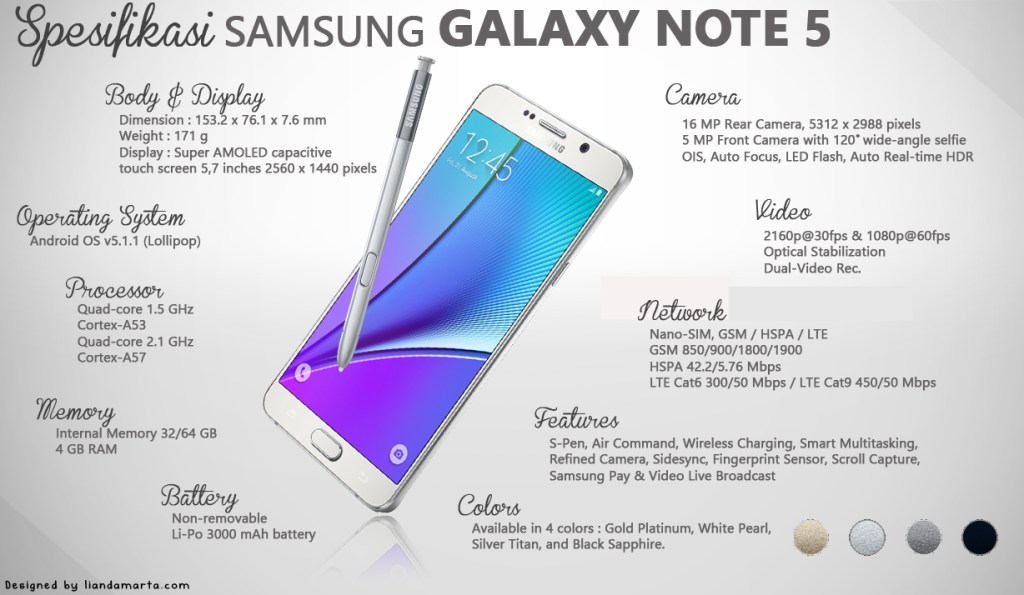Samsung Galaxy Note 5 GSM Network Compatibility
Samsung galaxy note 5 specification gsm – The Samsung Galaxy Note 5, released in 2015, boasted impressive specifications for its time. Understanding its GSM network compatibility is crucial for users, especially those who travel internationally or need reliable connectivity in different regions. This section details the Note 5’s GSM capabilities, comparing it to contemporaries and exploring its implications for global usage.
GSM Frequencies Supported by the Samsung Galaxy Note 5

Source: co.id
The Samsung Galaxy Note 5 supported a range of GSM frequencies, ensuring connectivity across various regions. However, it’s essential to note that specific frequency band support varied slightly depending on the carrier and region of purchase. The table below provides a general overview.
Understanding the Samsung Galaxy Note 5 specification, particularly its GSM capabilities, is crucial for potential buyers. For a comprehensive overview of Samsung’s offerings and their pricing, you might find the information on samsung galaxy mobiles with price and specification helpful. Returning to the Note 5, its GSM specs are key to determining network compatibility before purchase.
| Frequency Band | Region | Frequency (MHz) | Notes |
|---|---|---|---|
| GSM 850 | North America, parts of Latin America, Asia | 824-849 MHz (Uplink), 869-894 MHz (Downlink) | Widely used globally |
| GSM 900 | Europe, Asia, Africa, Australia | 890-915 MHz (Uplink), 935-960 MHz (Downlink) | Common in many regions |
| GSM 1800 | Europe, Asia, Australia, parts of Africa | 1710-1785 MHz (Uplink), 1805-1880 MHz (Downlink) | Popular in many countries |
| GSM 1900 | North America, parts of Latin America, Asia | 1850-1910 MHz (Uplink), 1930-1990 MHz (Downlink) | Common in North America |
GSM Capabilities Compared to Contemporary Flagship Phones
Compared to other flagship phones launched around 2015, such as the iPhone 6s and LG G4, the Note 5’s GSM capabilities were generally competitive. While specific frequency band support varied slightly between models, most offered similar global coverage. The main differentiators were often related to LTE and other advanced network technologies rather than basic GSM functionality.
Implications of GSM Frequency Compatibility for International Travel
The Note 5’s GSM frequency support significantly impacted its usability during international travel. Users traveling to regions with different GSM frequency bands than their home network could experience connectivity issues. Prior research on the local network frequencies was vital to ensure seamless communication and data access.
Note 5 Hardware Specifications Relevant to GSM
The Note 5’s hardware significantly influenced its performance on GSM networks. The processor, RAM, and internal storage all played a role in data speeds, call quality, and overall user experience.
Impact of Hardware Components on GSM Network Performance

Source: wordpress.com
- Processor: A powerful processor efficiently handled data processing and signal management, leading to faster data speeds and clearer calls.
- RAM: Ample RAM ensured smooth multitasking and prevented performance bottlenecks during data-intensive tasks, improving overall network responsiveness.
- Internal Storage: Sufficient storage space accommodated apps and data without impacting network performance.
Hardware Comparison: Note 5 vs. Competitor
A comparison against a competitor like the iPhone 6s reveals similar processing power and RAM, leading to comparable GSM performance. Differences in internal storage and other features were not directly tied to GSM network capabilities.
| Feature | Samsung Galaxy Note 5 | iPhone 6s | Notes |
|---|---|---|---|
| Processor | Exynos 7420 or Qualcomm Snapdragon 808 | Apple A9 | Both offered high-performance processors |
| RAM | 4 GB | 2 GB | Note 5 had more RAM, potentially improving multitasking under heavy network load |
| Internal Storage | 32 GB, 64 GB | 16 GB, 64 GB, 128 GB | Storage differences did not directly affect GSM performance |
Software and its Influence on GSM Functionality
The Note 5’s Android operating system and network settings played a crucial role in optimizing GSM connectivity. Proper configuration ensured optimal performance and addressed potential issues.
Optimizing GSM Connectivity on the Note 5
Regular software updates were essential for maintaining optimal GSM performance. Users should also ensure that network settings were correctly configured for their specific carrier and region. Selecting the appropriate network mode (e.g., GSM/WCDMA/LTE) could improve connectivity in areas with weak signals.
Potential Software Issues Affecting GSM Functionality, Samsung galaxy note 5 specification gsm
Outdated software or corrupted system files could negatively impact GSM functionality. Troubleshooting steps include restarting the device, checking for software updates, and performing a factory reset (as a last resort). Contacting the carrier’s technical support could also resolve complex issues.
Real-World Performance on GSM Networks
Real-world experiences with the Note 5 on GSM networks varied depending on several factors. Signal strength, network congestion, and roaming all played a role in the overall performance.
Comparative Analysis of GSM Performance
In areas with strong signals, the Note 5 generally provided reliable call quality and decent data speeds. However, in areas with weak signals or high network congestion, call drops and slow data speeds were more common. Roaming often resulted in slower speeds and potentially higher costs.
| Network Condition | Call Quality | Data Speed | Battery Life |
|---|---|---|---|
| Strong Signal | Excellent | Good | Average |
| Weak Signal | Fair to Poor | Slow | Reduced |
| High Congestion | Intermittent | Very Slow | Significantly Reduced |
| Roaming | Variable | Slow to Very Slow | Reduced |
Illustrative Examples of GSM Usage with the Note 5: Samsung Galaxy Note 5 Specification Gsm
A typical day’s usage might involve making several voice calls, sending text messages, checking emails, browsing the web, and using various apps. These activities all utilize GSM technology for communication and data transfer.
GSM Usage Scenarios and Potential Issues
- Voice Calls: Clear calls are expected in areas with good signal strength. Poor call quality or dropped calls may occur in areas with weak signals or network congestion.
- Text Messaging: SMS messages generally transmit reliably. However, delays may occur during periods of high network traffic.
- Data Transfer: Data speeds vary depending on network conditions and signal strength. Slow speeds or connection drops are possible in areas with poor coverage or network congestion.
Solutions to potential issues include moving to an area with better signal strength, restarting the phone, checking network settings, and contacting the carrier for assistance.
Question & Answer Hub
Does the Samsung Galaxy Note 5 support VoLTE?
While the Note 5 supports 4G LTE, VoLTE (Voice over LTE) support depends on carrier compatibility. Check with your provider to confirm VoLTE availability.
How can I improve the Note 5’s battery life on GSM networks?
Reduce screen brightness, limit background app activity, and disable features like location services when not in use. Consider using power-saving modes offered by the device.
What are the common causes of dropped calls on a GSM network with the Note 5?
Weak signal strength, network congestion, SIM card issues, or software glitches can all contribute to dropped calls. Try restarting your phone, checking for software updates, and ensuring your SIM card is properly inserted.